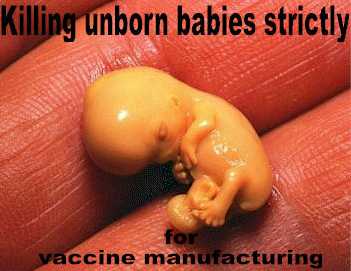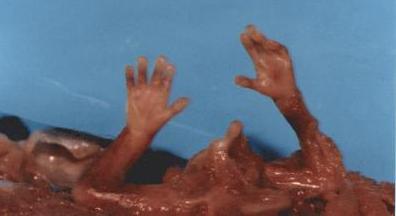35% of Puerto Rican Women Sterilized!
 A
hitherto "secret" report from an economic policy group empowered by the
Governor of Puerto Rico has recently surfaced in the United States. One can
see immediately why the report, dated November, 1973, has been kept from the
public: it talks openly and directly about alternatives available for
reducing the ranks of the Puerto Rican working class.
A
hitherto "secret" report from an economic policy group empowered by the
Governor of Puerto Rico has recently surfaced in the United States. One can
see immediately why the report, dated November, 1973, has been kept from the
public: it talks openly and directly about alternatives available for
reducing the ranks of the Puerto Rican working class.
As the report, entitled "Opportunities for Employment, Education and Training" would have it, Puerto Rico's key problem is, and has always been, unemployment.
The latest official figure given in the report is an unemployment rate of 12.3% in 1972 (although unofficial sources, such as the Puerto Rican Chamber of Commerce, hold it as high as 30%); what concerns this particular subcommittee of colonial administrators is that, at the rate things are going, unemployment could reach 18.5% by 1985.
" The Governor of Puerto Rico recently selected the figure of 5% unemployment by 1985", the report underlines. There is clearly a major discrepancy between the two figures, which presents a tough problem to the subcommittee. How to solve it?
The members of the subcommittee -Teodoro Moscoso, Administrator of Fornento, Secretary of Labor Silva Recio, Secretary of Education Ramon Cruz, and the then President of the University of Puerto Rico Amador Cobas, have come up with two solutions. One way is to foster new jobs --the same solution which has been advocated throughout Puerto Rico's twenty-five years of industrial development, and which has yet to reduce the high unemployment rate. The other, which they go on to discuss immediately, is to "reduce the growth of the working sector" of the population.
Their line of attack is two-pronged, involving the massive sterilization of Puerto Rican working-class women, and a forced migration of Puerto Rican workers to the United States. It is the former aspect of this plan which concerns us here.
The Sterilization Plan
Under the heading of "organization and focuses of family planning", the November report estimates the female population of child-bearing age outside of San Juan to be 485,948. Agreeing with other studies on the astounding figure of 33% for the number of Puerto Rican women of child-bearing age that have already been sterilized, the report goes on to say "in other words, of the 485,948 women of reproductive age living in Puerto Rico, excepting the area of San Juan, 160,363 are sterilized. This leaves a potential clientele of 325,585 women . . ."
The women of San Juan are to be handled through a "model project" controlled by the School of Public Health of the University of Puerto Rico.
The plan then, involves the entire population of Puerto Rican women of child-bearing age in its scope, and the primary method of birth control? What it has always been in Puerto Rico -sterilization.
One-Third of Puerto Rican Women Sterilized
Figures from different studies give a general picture of the rate of sterilization of Puerto Rican women over the past four decades.
In 1947-48, Paul K. Hatt, in a study of 5,257 ever-married women 15 years old or over, found that 6.6 per cent had been sterilized. A figure more or less equal (6.9 per cent) was put forward in 1948 by Emilio Cofresi from studies of women who were clients of various programs of the Department of Health in Puerto Rico.
In an island-wide survey carried out by Hill, Stycos and Back in 1953-54, the prevalence of female sterilization of ever-married women 20 years old or over was estimated at 16.5 per cent.
In 1965 the Puerto Rican Department of Health carried out an island-wide study on the relationship between cancer of the uterus and female sterilization. Although the Department of Health says no link between cancer and sterilization was substantiated, it did discover that 34% of Puerto Rican women between the ages of 20-49 years were sterilized.
The number of women sterilized in the same age group rose to 35.3% in 1968 according to a study by the Puerto Rican demographer Dr. lose Vasquez Calzada.
The incidence of sterilization in Puerto Rico is the highest in the world. India and Pakistan, for example, which have public sterilization programs, have an estimated sterilization of 5% and 3% respectively.
The Colonial Context
What is the context in which this massive sterilization was taking place? Since its invasion of Puerto Rico in 1898, the United States has maintained virtually complete control over the island's development. Until 1952, the Governor of Puerto Rico was appointed by the President of the United States, and had veto power over a local House of Representatives. Civil services, armed forces, police; mail, citizenship, trade agreements, schools, media, and economic programs were under U.S. supervision.
The establishment of the Commonwealth Government in 1952 in no way changed the fact of US control, since Congress still maintained ultimate veto power over any law passed by the Puerto Rican Government, and any law passed by Congress automatically applied to Puerto Rico. What the Commonwealth Government did do was supervise the influx of U.S. corporations in a rapid industrialization program during the fifties, which transformed Puerto Rico from a sugar economy to one of the most highly industrialized countries in the world.
Population Control -A U.S. Theory
In 1901 Governor of Puerto Rico William Hunt wrote in his report to the President of the United States: "Not only could it [the island] comfortably keep the one million inhabitants we have now, but five times that number."
By the thirties, however, J.M. Stycos reports in "Female Sterilization in Puerto Rico" that a good many doctors were already aware of the "problems of population". He cites the efforts of Dr. Jose Belavel, head of the Pre-Maternal Health program to interest many physicians in the "pressing need for sterilization and birth control".
During the thirties in the United States population control research was being carried on by the Rockefeller Foundation.
Theories were circulating expressing the general idea that economic problems in underdeveloped countries were really problems of too many people; if only the population growth could be controlled, the standard of living would rise.
The population theories, as the newsletter of the North American Congress on Latin America (NACLA) entitled "Population Control in the Third World" indicates, had, and still have, strongly racist roots, based on the concept of the safeguarding the superior white civilization from the crude and inferior "underdeveloped" world which threatens to overwhelm the globe with its "population explosions."
For the United States, there was the particular problem of keeping the colonial population of Puerto Rico under control. By 1933 U.S. sugar companies had monopolized 314,000 acres. Thousands of impoverished farmers, forced from their lands, migrated to the cities or became agricultural laborers on sugar plantations where wages averaged 37 cents per day. This had its political consequence: caneworkers began to organize militant unions, and nationalism was growing. What better way to obscure the real problem of U.S. control of the island than by blaming it on population growth? A quote from a Puerto Rican legislator during the time, (taken from Back, Hill and Stycos: "Population Control in Puerto Rico"), expresses this confusion:
" . . . those of us who have discussed maldistribution of Puerto Rican lands and its growing absentee ownership must realize that these problems are growing more and more serious through our existing surplus population and its constant growth, particularly in recent years. The inevitable consequence is increasing unemployment, growing poverty and mounting misery."
According to Harriet Presser in "The Role of Sterilization in Controlling Puerto Rican Fertility", sterilization was introduced into Puerto Rico in the 1930's, along with contraception methods. In 1934, 67 birth control clinics were opened with federal funds channeled through the Puerto Rican Emergency Relief Fund. The funds lasted only two years; then in 1936 the private Maternal and Childcare Health Association opened 23 clinics.
The Family Planning Association of Puerto Rico, another private organization, was established in 1954, two years after the Population, Council was formed in the United States by John D. Rockefeller. During the next ten years, according to Presser, it subsidized sterilization in private facilities for 8,000 women. Between 1956 and 1966 it also subsidized sterilization of 3000 men. This organization still functions today, and has an important role to play in the future, according to the November, 1973 report. Presently it receives $750,000.00 of its $900,000.00 budget from the federal Department of Health, Education and Welfare.
Thousands of sterilizations also took place in public hospitals. In 1949 the Commissioner of Health in Puerto Rico was quoted in El Mundo as saying he would favor the use of district hospitals once or twice a week to perform fifty sterilizations a day.
Many doctors were pro-sterilization rather than other forms of birth control. "Many physicians thought, and still think," says J.M. Stycos, that contraception methods are too difficult for lower class Puerto Ricans and regarded post-partum sterilization
as the most feasible solution to the [population] problems".
An experience of one pre-medical student in Puerto Rico in the 1950's, told to us by an informed source, indicates that this preference for sterilization was not only an obviously racist attitude, but a policy.
As part of her training, the student was told that any pregnant woman who came into the hospital for a delivery who had already had two or more children must have her tubes tied after giving birth. This was standard procedure, checked afterwards by another doctor to make sure that it was carried out.
Generally, it seems that most sterilizations were carried out post partum. In 1949, using J.M. Stycos' work again, 17.8 per cent of all hospital deliveries were followed by sterilization. Stycos notes that these figures may underestimate the actual incidence of sterilization because it did not count the women who had home deliveries and then hospital sterilization; also, not all sterilizations may be recorded as such in the hospital records, he adds.
Private hospitals also had an exceptionally high incidence of sterilization in proportion to deliveries, says Presser. She cites one hospital that had to reduce its sterilizations to 25% of all deliveries because of outside pressure.
Presser indicates that most sterilizations have been post-partum, and that "enabling an increasing incidence has been the continued rise in hospital deliveries", which went from 10 per cent in 1940 to 37.7 per cent in 1950, 77.5 per cent in 1960 and 90 per cent in 1965, according to the Puerto Rican Department of Health.
Hospitals in Puerto Rico are substantially financed by the United States government. The entire medical apparatus in Puerto Rico was developed by the United States; training was carried on by U.S. doctors. Many of the doctors working in Puerto Rico and performing sterilizations have been and are today from the United States.
The United States carries on population control programs throughout the third world, most of which, according to NACLA, are financed by the Agency for International Development. Some AID programs, such as the "Family Planning Insurance" in Costa Rica actually offer money in return for sterilization.
Puerto Rico's colonial status gives the United States the ability to carry on effective population control programs in the world.
The increased sterilization of Puerto Ricans becomes more and more necessary as the U.S. industrial plans for the island -plans which profit U.S. corporations, and do not build a future for the inhabitants of Puerto Rico -develop. This becomes clearer as we continue to explore the ramifications of the report "Opportunities for Employment, Education & Training."







